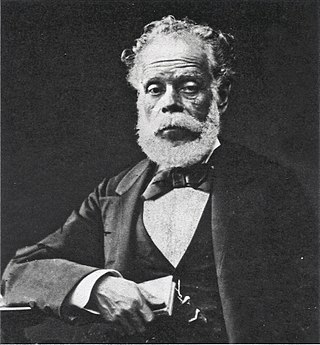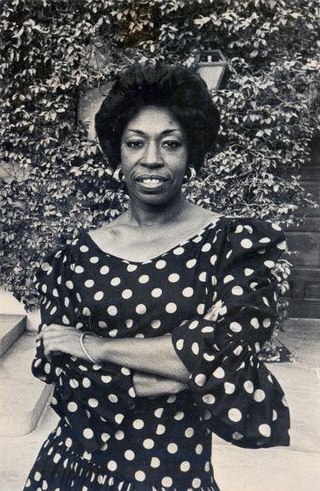Related Research Articles
Peruvian music is an amalgamation of sounds and styles drawing on Peru's Andean, Spanish, and African roots. Andean influences can perhaps be best heard in wind instruments and the shape of the melodies, while the African influences can be heard in the rhythm and percussion instruments, and European influences can be heard in the harmonies and stringed instruments. Pre-Columbian Andean music was played on drums and string instruments, like the European pipe and tabor tradition. Andean tritonic and pentatonic scales were elaborated during the colonial period into hexatonic, and in some cases, diatonic scales.
In music, call and response is a compositional technique, often a succession of two distinct phrases that works like a conversation in music. One musician offers a phrase, and a second player answers with a direct commentary or response. The phrases can be vocal, instrumental, or both. Additionally, they can take form as commentary to a statement, an answer to a question or repetition of a phrase following or slightly overlapping the initial speaker(s). It corresponds to the call and response pattern in human communication and is found as a basic element of musical form, such as verse-chorus form, in many traditions.
Cumbia refers to a number of musical rhythms and folk dance traditions of Latin America, generally involving musical and cultural elements from American Indigenous peoples, African slaves during colonial times, and Europeans. It is said to have come from funeral traditions in the Afro-Colombian community.

Lundu is a style of Afro-Brazilian music and dance with its origins in the African Bantu and Portuguese people.

A cajón is a box-shaped percussion instrument originally from Peru, played by slapping the front or rear faces with the hands, fingers, or sometimes implements such as brushes, mallets, or sticks. Cajones are primarily played in Afro-Peruvian music, but have made their way into flamenco as well. The term cajón is also applied to other box drums used in Latin American music, such as the Cuban cajón de rumba and the Mexican cajón de tapeo.
Afro-Peruvian music, or Música negra, is a type of Latin American music first developed in Peru by enslaved black people from West Africa, where it is known as Festejo. The genre is a mix of West African and Spanish music.

Huayno is a genre of popular Andean music and dance. It is especially common in Peru, Western Bolivia, Northern Argentina and Northern Chile, and is practiced by a variety of ethnic groups, especially the Quechua people. The history of Huayno dates back to colonial Peru as a combination of traditional rural folk music and popular urban dance music. High-pitched vocals are accompanied by a variety of instruments, including quena (flute), harp, siku (panpipe), accordion, saxophone, charango, lute, violin, guitar, and mandolin. Some elements of huayno originate in the music of the pre-Columbian Andes, especially on the territory of the former Inca Empire. Huayno utilizes a distinctive rhythm in which the first beat is stressed and followed by two short beats.

Cueca is a family of musical styles and associated dances from Chile, Argentina, and Bolivia. In Chile, the cueca holds the status of national dance, where it was officially declared as such by the Pinochet dictatorship on September 18, 1979.
Música criolla or canción criolla is a varied genre of Peruvian music that exhibits influences from European, African and Andean music. The genre's name reflects the coastal culture of Peru, and the local evolution of the term criollo, a word originally denoting high-status people of full Spanish ancestry, into a more socially inclusive element of the nation.

Marinera is a partner dance that originated along the coastal regions of Peru, using handkerchiefs as props. The dance is a mix of Spanish contradanza and Andean zamacueca, and is a stylized reenactment of a courtship, showing a blend of the different cultures of Peru. The dance has gained recognition throughout South America and is known as the most prominent traditional dance of Peru. The city of Trujillo has been recognized as the national birthplace of the marinera since 1986. The Marinera Festival, a cultural event dedicated to marinera held in Trujillo, has held annual competitions of the dance since 1960. In 2012, the Congress of Peru observed nationally October 7 as a commemorative day for the marinera.

Tondero is a dance and guitar rhythm from Peru that developed in the country's northern coastal region (Piura–Lambayeque).

Zamba is a traditional dance of Argentina. It is a style of Argentine music and Argentine folk dance. Zamba is very different from its homophone, the samba - musically, rhythmically, temperamentally, in the steps of the dance and in its costume. It has six beats to the bar and is a majestic dance, performed by couples who circle each other waving white handkerchiefs very elegantly. It has common elements with the cueca.

Margot Loyola Palacios was a musician, folk singer and researcher of the folklore of Chile and Latin America in general.

Dance in Peru is an art form primarily of native origin. There are also dances that are related to agricultural work, hunting and war. In Peru dancing bears an important cultural significance. Some choreographies show certain Christian influence.
Festejo is a festive form of Afro-Peruvian music. The dance is a staple in the Black coastal populations and it celebrates the emancipation of slaves. Festejo is recognized for its high energy and the improvisation carried out by the dancers. Some believe that its origins trace back to competitive dance circles performed by individuals playing cajóns. Despite its African origins, people of all different backgrounds participate in the dance that many regards as one of the greatest representations of Peruvian culture.

Afro-Chileans are Chilean people of African descent. They may be descendants of slaves who were brought to Chile via the trans-Atlantic slave trade, or recent migrants from other parts of Latin America, the Caribbean or Africa.
Peruvian cumbia is a subgenre of chicha that became popular in the coastal cities of Peru, mainly in Lima in the 1960s through the fusion of local versions of the original Colombian genre, traditional highland huayno, and rock music, particularly surf rock and psychedelic rock. The term chicha is more frequently used for the pre-1990s variations of the subgenre.

Francisco Fierro Palas, called "Pancho" Fierro, was a Peruvian painter, known primarily for his costumbrista watercolors, which depict his country's life and customs.

Victoria Eugenia Santa Cruz Gamarra was an Afro-Peruvian choreographer, composer and activist.
References
- ↑ Shiroma, Gabriela (2008-09-29). "A Brief History of the Zamacueca and Description of the Marinera". Alliance for California Traditional Arts. Retrieved 2023-11-05.